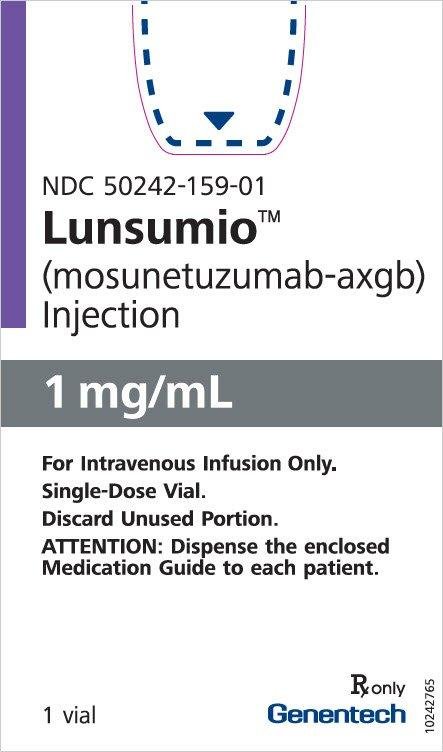Mosunetuzumab Side Effects
Medically reviewed by Drugs.com. Last updated on Oct 16, 2023.
Applies to mosunetuzumab: intravenous solution.
Warning
Intravenous route (Solution)
Warning: Cytokine Release SyndromeCytokine release syndrome (CRS), including serious or life-threatening reactions, can occur in patients receiving mosunetuzumab-axgb. Initiate treatment with the mosunetuzumab-axgb step-up dosing schedule to reduce the risk of CRS. Withhold mosunetuzumab-axgb until CRS resolves or permanently discontinue based on severity.
Serious side effects of Mosunetuzumab
Along with its needed effects, mosunetuzumab may cause some unwanted effects. Although not all of these side effects may occur, if they do occur they may need medical attention.
Check with your doctor or nurse immediately if any of the following side effects occur while taking mosunetuzumab:
More common
- Abnormal or decreased touch sensation
- agitation
- back pain
- blue lips and fingernails
- blurred vision
- body aches or pain
- bone pain
- burning, crawling, itching, numbness, prickling, "pins and needles", or tingling feelings
- burning, numbness, tingling, or painful sensations
- chest pain or tightness
- chills
- confusion as to time, place, or person
- cough
- coughing that sometimes produce a pink frothy sputum
- decrease in amount of urine
- difficulty in moving
- dizziness
- drowsiness
- ear congestion
- fast, noisy breathing
- fever
- frequent or painful urination
- hallucinations
- headache
- holding false beliefs that cannot be changed by fact
- increased sweating
- irritability
- joint pain
- loss of voice
- mental depression or anxiety
- muscle aches, cramps, pain, or stiffness
- neck pain
- nerve pain
- nightmares or unusually vivid dreams
- pain or tenderness around the eyes and cheekbones
- pale skin
- rapid or irregular heartbeat
- seizures
- sneezing
- sore throat
- stiff neck
- stomach pain
- stuffy or runny nose
- swelling
- swelling of the hands, ankles, feet, or lower legs
- swollen joints
- trembling and shaking of the hands
- trouble breathing
- trouble performing routine tasks
- trouble sleeping
- unsteadiness or awkwardness
- unusual excitement, nervousness, or restlessness
- unusual tiredness or weakness
- vomiting
- weakness in the arms, hands, legs, or feet
- weight gain
Incidence not known
- Black, tarry stools
- bleeding gums
- blood in the urine or stools
- lower back or side pain
- painful or difficult urination
- pinpoint red spots on the skin
- ulcers, sores, or white spots in the mouth
- unusual bleeding or bruising
Other side effects of Mosunetuzumab
Some side effects of mosunetuzumab may occur that usually do not need medical attention. These side effects may go away during treatment as your body adjusts to the medicine. Also, your health care professional may be able to tell you about ways to prevent or reduce some of these side effects.
Check with your health care professional if any of the following side effects continue or are bothersome or if you have any questions about them:
More common
- Diarrhea
- dry skin
- itching skin
For Healthcare Professionals
Applies to mosunetuzumab: intravenous solution.
General
-The most common adverse reactions with a frequency of 20% or greater were cytokine release syndrome , fatigue , rash , pyrexia , and headache.
-Adverse reactions that required dosage interruption in greater than or equal to 5% of patients included neutropenia, infection, and cytokine release syndrome.[Ref]
Dermatologic
Rash included rash erythematous, exfoliative rash, rash macular, rash maculo-papular, rash papular, rash pruritic, rash pustular, erythema, palmar erythema, dermatitis, and dermatitis acneiform.[Ref]
Very common (10% or more): Dry skin (16%), pruritus (21%), rash (39%)
Common (1% to 10%): Skin exfoliation[Ref]
Gastrointestinal
Abdominal pain included lower abdominal pain and abdominal discomfort.[Ref]
Very common (10% or more): Abdominal pain (12%), diarrhea (17%), nausea (17%)[Ref]
Genitourinary
Common (1% to 10%): Urinary tract infection[Ref]
Urinary tract infection included urinary tract infection and acute pyelonephritis.[Ref]
Hematologic
Very common (10% or more): Decreased lymphocyte count (100%), decreased hemoglobin (68%), decreased neutrophils (58%), decreased platelets (46%), decreased white blood cells (60%)[Ref]
Immunologic
Very common (10% or more): Cytokine release syndrome (44%)[Ref]
Metabolic
Very common (10% or more): Uric acid increased (22%)
Frequency not reported: Tumor lysis syndrome[Ref]
Musculoskeletal
Musculoskeletal pain included back pain, myalgia, musculoskeletal chest pain, and neck pain.[Ref]
Very common (10% or more): Arthralgia (11%), musculoskeletal pain (28%)[Ref]
Nervous system
Headache included headache and migraine. Peripheral neuropathy included peripheral sensory neuropathy, paresthesia, dysesthesia, hypoesthesia, burning sensation, and neuralgia. Dizziness included dizziness and vertigo. Motor dysfunction included ataxia, gait disturbance and tremor.[Ref]
Very common (10% or more): Dizziness (12%), headache (32%), peripheral neuropathy (20%)
Frequency not reported: Motor dysfunction[Ref]
Oncologic
Frequency not reported: Tumor flare
Other
Fatigue included asthenia, and lethargy. Edema included edema peripheral, peripheral swelling, face edema, swelling face, pulmonary edema, fluid overload, and fluid retention.[Ref]
Very common (10% or more): Chills (13%), decreased platelets (46%), decreased phosphate (78%), decreased magnesium (33%), edema (17%), fatigue (42%), increased glucose (42%), increased aspartate aminotransferase (39%), increased alanine aminotransferase (32%), increased gamma-glutamyl transferase (34), pyrexia (29%)
Frequency not reported: EBV viremia, sepsis[Ref]
Psychiatric
Very common (10% or more): Insomnia (12%)
Frequency not reported: Mental status changes, anxiety[Ref]
Renal
Frequency not reported: Renal insufficiency[Ref]
Respiratory
Cough includes cough, productive cough, and upper airway cough syndrome. Dyspnea included dyspnea and dyspnea exertional. Upper respiratory tract infection includes upper respiratory tract infection, nasopharyngitis, sinusitis, and rhinovirus infection.[Ref]
Very common (10% or more): Dyspnea (11%), cough (22%), upper respiratory tract infection (14%)
Frequency not reported: COVID-19, pneumonia[Ref]
More about mosunetuzumab
- Check interactions
- Compare alternatives
- Reviews (1)
- Dosage information
- During pregnancy
- Drug class: miscellaneous antineoplastics
- Breastfeeding
- En español
Patient resources
Other brands
Professional resources
Other brands
Related treatment guides
References
1. Product Information. Lunsumio (mosunetuzumab). Genentech. 2022.
Further information
Always consult your healthcare provider to ensure the information displayed on this page applies to your personal circumstances.
Some side effects may not be reported. You may report them to the FDA.

